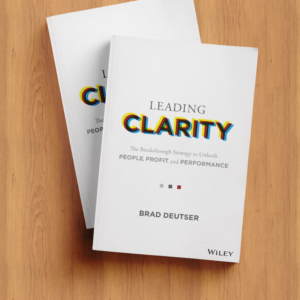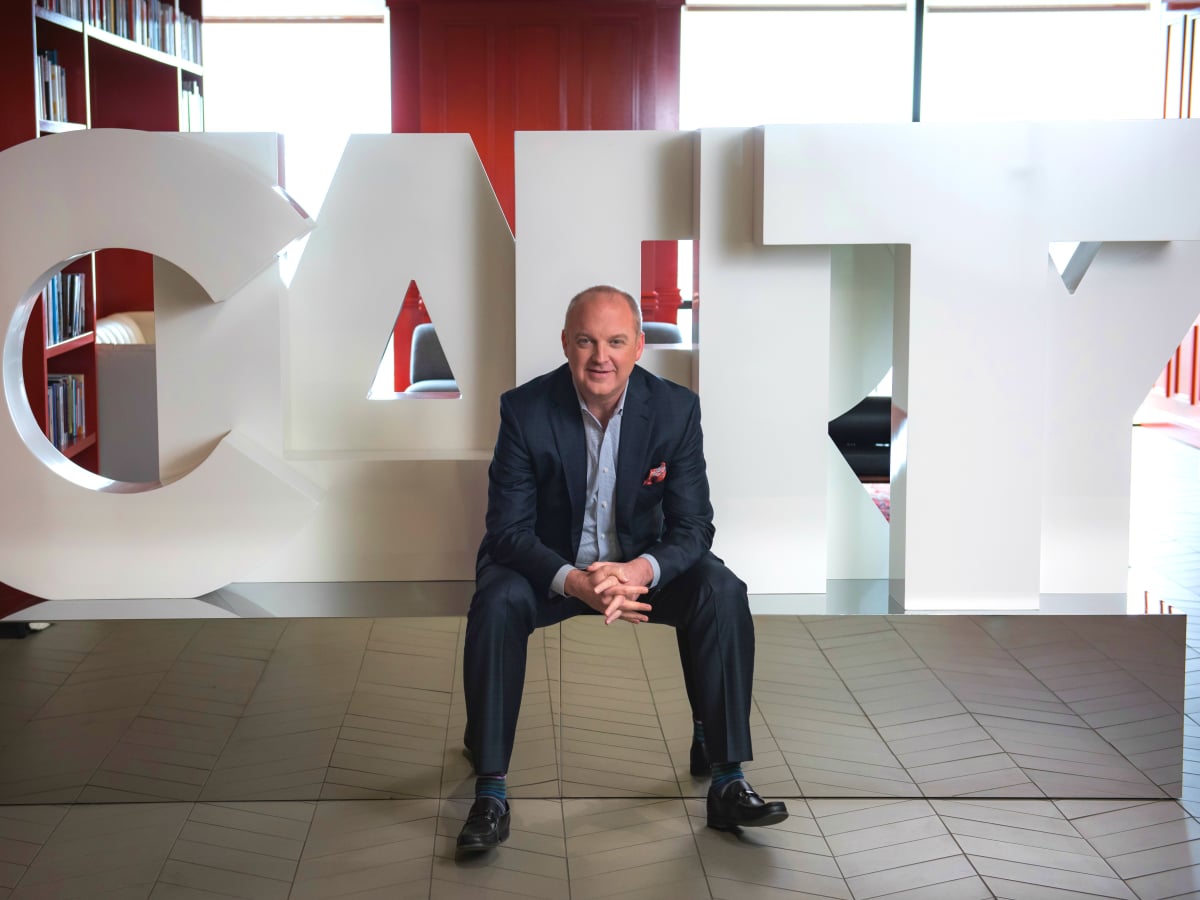Lead With Clarity
One of the most common problems facing organizations, teams, and leaders today is a lack of clarity. Clarity is a critical component of success. We all want it, even crave it, but it often seems elusive.
Brad Deutser argues that clarity can be created and help drive people, profit, and performance when it’s found. Brad is founder and CEO of management consulting firm Deutser, and he has worked with a variety of businesses from numerous industries. I found his new book, Leading Clarity: The Breakthrough Strategy to Unleash People, Profit, and Performance, an exceptional read.
We then talked about leadership and clarity:
The Clarity Conundrum
What is the clarity conundrum?
The constant state of change and ever-present chaos in the world today is unprecedented. We are constantly navigating not one world, but multiple worlds simultaneously with the political, societal, social and technological changes that are happening at a more rapid pace than at any time in history. Leaders are forced to make daily decisions in a high-stakes environment that is often entangled with competing needs and priorities where there is not one obvious answer. These decisions have the potential to define their company and determine their ultimate success. We identify these decisions, inflection points or daily puzzles as clarity conundrums. They take many different forms in companies and in the lives of the leader. Clarity conundrums include the need for a new vision/direction, repositioning, a growth imperative, and they often result from a merger, a new leader, an acquisition, a safety issue, crisis, or hitting a plateau or reaching critical juncture point in the organization. What they all have in common is that they require clarity, as a process, to successfully navigate the necessary transition to the desired future state.
Think Inside the Box
Why do you advocate thinking inside the box? I love it, and it’s counterintuitive from all the advice commonly shared.
For much of my early career, I was prized as an out of the box thinker. Clients could rely on me to produce ideas and solutions that were fundamentally different and way outside the mainstream. I was wildly creative – but that creativity did not always align with the desired results. About two decades ago, I began to rethink the box paradigm, and using client results and research began to validate that “inside the box” is actually where real creativity, innovation and performance are birthed. Interestingly, in our early research, we challenged people to define their box. Most people simply accepted the metaphor without assigning definition to it. When we uncovered the parameters of the box and put clear definition to each side, including the top and bottom, we were able to fundamentally change the trajectory of business for our clients and the connectivity of the workforce to the organization and its leadership. Inside the box thinking allows leaders to have a clearly defined organization and direction, and employees to have something that they can understand and belong to. It is a game changer.
I love the box model for clarity. There are six sides to clarity. How do leaders best assess their six sides and work in the most efficient way to gain clarity for their organizations?
When we think about our box – most people think about the flat 4-sided box. But in reality, the box is dimensional and six-sided. We work with leaders of all levels of organizations to understand each side of their box. We use a tool, the Clarity Performance Index, that gives each person in the organization the opportunity to weigh in on the 4 sides of the box – Direction, Operations, People and Engagement. We also share a version of the tool in my book, Leading Clarity, for leaders to begin to understand their company’s score that gives some insight into their current state and more, the balance that exists between each of the sides. For the bottom of the box, we work through a powerful exercise to understand and begin to humanize the values, purpose, organizational characteristics and behavioral drivers for the company. And, at the top of the box, we use a variety of exercises to analyze the outside environment and the external factors that are influencing their business. Understanding and defining the box is the essential first step in the clarity process.

Purposeful positivity shows up in your work. Would you share one of your exercises to help build this?
Positive psychology is a foundational element of our company and our belief system. We have taken it a step further by ensuring a measure of intentionality, or what we call purposeful positivity, into our mindset. Leaders can talk about being positive, but rarely drive that positivity through the culture of the organization. We work with leaders to make this part of the operational DNA of the company with our work in strategy, culture, communications and on-going coaching and evaluation. We incorporate a number of daily and weekly exercises to reinforce the expectation and norm the mind around the desired positivity framework. A daily exercise we incorporate is Circuit Breakers – where we challenge individuals to identify the things that are inhibiting their natural positive flow of energy. Another exercise is the Sitcom – where we ask leaders to create a sitcom using the people in their company, department or life as a means to recognize the ability others have to negatively impact them and the culture they are trying to establish. But, the exercise I encourage all leaders and all people to consider each week is the Purposeful Positivity exercise where each person is asked to identify three things that created negativity to leave behind, identify 5 things that bring positive value to bring forward, and 10 things that we are grateful for creating or simply being a part of. By taking the time to actively put positive ideas down and release negative thoughts, we are able to begin to reinforce the purposeful positivity that is proven to drive our performance.
Would you comment on dimensionality – what is it, and how you’ve experienced it?
Leaders are faced with complexity at every turn in our constantly evolving world and business environment. Change is the one constant we can all rely on. Organizations and key departments must be able to adapt on the fly to the fluidity of the environment around them. No longer can leaders rely on the one-dimensional solutions to solve problems – even if they are the tried and tested strategy – or clever communications that may have historically worked as stand-alones. That is why clarity as a process is so unique and important – it informs and connects strategy, culture, innovation and communication in new and different ways. It ensures a level of understanding, connection and dimensionality of thought that mirrors and elevates the construct of the box. When we are able to make different connections in our planning and solving stages, we are able to arrive at solutions that provide a different level of sustainability and endurance.
Linger in the Question
I love what you call “Linger in the Question”. How can leaders use this technique to improve clarity?
So much of being in clarity is being purposeful in our understanding of not only ourselves, but others. Too often, the leader that is perceived to be the decisive leader is prized over the deeper, more thoughtful, sometimes viewed as more deliberate, leader. Again, we cannot divorce ourselves from the reality of the work environment today – we are in a constant state of transition, regardless of the success or standing of the company. That state requires us to stay in the question longer than we might have previously allowed ourselves. It forces us to avoid jumping to conclusions, regardless of how obvious they may seem, and more empathetically demands us to be in the shoes or minds of the person or persons with whom we are working to create a deeper connection. While our team often uses a Deutser-ized form of empathy mapping to go deeper into the wants and needs of the other person, there are a series of questions that any leader can ask to ensure they are lingering in the question. They include: What do they care about? What motivates them? What is their unique situation? What do we want them to think, feel, and do differently in the future? While the questions are important, it is more important to give yourself the space to linger in the question and get the better answer.
What do you mean when you talk about “alignment”? How do leaders best create a culture that encourages it?
 To many leaders, alignment is that feeling when things seem to be flowing naturally and the company is experiencing success up and down the organization. They equate it to the runner’s high – things just seem easy and more natural. As we think about alignment, it is a more intentional act or process, and it corresponds directly to the box. The box allows for common understanding, definition and expectation for not only the leader, but the entirety of the workforce. When everyone rallies around the defined expectations, and people are recognized and rewarded for their performance around each of those expectations, it helps to ensure alignment. We often start by placing great focus on the bottom of the box and ensuring that everyone has the foundational understanding of who we are as a company, why we exist and what behaviors we expect at every level. We call it “the company way,” and we not only work to educate the workforce with purposeful education, engagement and communication but evaluate, recognize and reward around the things that matter most to the company. Again, we are big believers that it is not the environment that defines performance, it is the expectations we set that direct alignment and drive performance.
To many leaders, alignment is that feeling when things seem to be flowing naturally and the company is experiencing success up and down the organization. They equate it to the runner’s high – things just seem easy and more natural. As we think about alignment, it is a more intentional act or process, and it corresponds directly to the box. The box allows for common understanding, definition and expectation for not only the leader, but the entirety of the workforce. When everyone rallies around the defined expectations, and people are recognized and rewarded for their performance around each of those expectations, it helps to ensure alignment. We often start by placing great focus on the bottom of the box and ensuring that everyone has the foundational understanding of who we are as a company, why we exist and what behaviors we expect at every level. We call it “the company way,” and we not only work to educate the workforce with purposeful education, engagement and communication but evaluate, recognize and reward around the things that matter most to the company. Again, we are big believers that it is not the environment that defines performance, it is the expectations we set that direct alignment and drive performance.
Lastly, I’d love to touch on what you call “masqueraders of clarity.” Would you share one or two of them and how they appear and derail progress?
This is one of my favorite topics in the book and one of the most important areas as we think about the things that distract us from being in alignment and in clarity. Masqueraders are things or people who appear to bring value and forward motion, but in reality, are tricksters that derail our forward or intended progress. They cloud our thinking, waste time, energy and money, and inhibit our ability to do what is right and best for the organization. There are many masqueraders of clarity inside organizations, some include suck-ups and people pleasers, past performance, best practices and outdated mandates, policy, boards and founders. While each can have stand-alone value, they also can become and often exist as masqueraders inside of companies. One of the masqueraders that I am particularly aware of is political correctness. In our work, we are seeing more and more of this masquerader influence direction and divert our clients from where they need to go. With political correctness, leaders believe they are having an appropriate conversation – but in reality, many times, both sides of the discussion are compromising what they really mean and having a conversation based on 50% of the truth. This means leaders are at best making an educated guess at what the other side is really saying. This is dangerous and creating a false foundation from which to lead and create success. Of course, we understand and encourage the sensitivity lens to be included in conversations, but with 100% of the truth to ensure the masquerader is kept away.
For more information, see Leading Clarity: The Breakthrough Strategy to Unleash People, Profit, and Performance.


